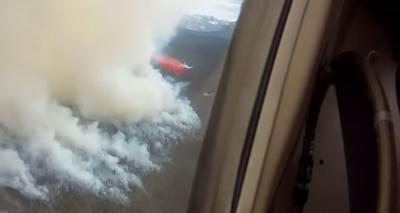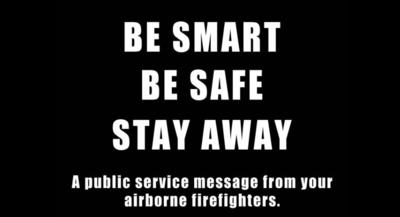Thu, Jul 30, 2015
Several Recent Incidents Reported In Which UAVs Interfered With Firefighting Aircraft
Responding to recent incidents in which unmanned aircraft systems (UAS), also known as “drones,” interfered with manned aircraft involved in wildland firefighting operations, the FAA is supporting the U.S. Department of the Interior and U.S. Forest Service in their simple message to drone operators: If you fly; we can’t.

“Flying a drone near aerial firefighting aircraft doesn’t just pose a hazard to the pilots,” said U.S. Transportation Secretary Anthony Foxx. “When aircraft are grounded because an unmanned aircraft is in the vicinity, lives are put at greater risk.”
Often a temporary flight restriction (TFR) is put in place around wildfires to protect firefighting aircraft. No one other than the agencies involved in the firefighting effort can fly any manned or unmanned aircraft in such a TFR. Anyone who violates a TFR and endangers the safety of manned aircraft could be subject to civil and/or criminal penalties. Even if there is no TFR, operating a UAS could still pose a hazard to firefighting aircraft and would violate Federal Aviation Regulations.
“The FAA’s top priority is safety. If you endanger manned aircraft or people on the ground with an unmanned aircraft, you could be liable for a fine ranging from $1,000 to a maximum of $25,000,” said FAA Administrator Michael Huerta. “Know the rules before you fly. If you don’t, serious penalties could be coming your way for jeopardizing these important missions.”
Since so many people operate unmanned aircraft with little or no aviation experience, the FAA is promoting voluntary compliance and working to educate UAS operators about how they can operate safely under current regulations and laws. The agency has partnered with industry and the modeling community in a public outreach campaign called “Know Before You Fly.”

The campaign recently reminded UAS users to respect wildfire operations. The National Interagency Fire Center also posted a video warning for users to, “Be Smart. Be Safe. Stay Away.”
Additionally, the FAA provided guidance to law enforcement agencies because they are often in the best position to deter, detect, immediately investigate, and, as appropriate, pursue enforcement actions to stop unauthorized or unsafe unmanned aircraft operations.
So remember this simple message around wildfires: If you fly, they can’t. Keep your drone on the ground and let firefighters and aircraft do their jobs. And, if you see someone flying a drone near a wildfire, report it immediately to local law enforcement and the nearest FAA Flight Standards District Office with as much information as possible.
(Images from YouTube video)
More News
Aero Linx: Model Aeronautical Association of Australia MAAA clubs are about fun flying, camaraderie and community. For over 75 years, the MAAA has been Australia’s largest fl>[...]
Touchdown Zone Lighting Two rows of transverse light bars located symmetrically about the runway centerline normally at 100 foot intervals. The basic system extends 3,000 feet alon>[...]
“Discovery and innovation are central to our mission at Virgin Galactic. We’re excited to build on our successful record of facilitating scientific experiments in subor>[...]
How To Get A Story On Aero-TV News/Feature Programming How do I submit a story idea or lead to Aero-TV? If you would like to submit a story idea or lead, please contact Jim Campbel>[...]
Student Pilot Reported That During Rotation, “All Of A Sudden The Back Of The Plane Kicked To The Right..." Analysis: The student pilot reported that during rotation, “>[...]
 ANN's Daily Aero-Linx (05.02.24)
ANN's Daily Aero-Linx (05.02.24) ANN's Daily Aero-Term (05.02.24): Touchdown Zone Lighting
ANN's Daily Aero-Term (05.02.24): Touchdown Zone Lighting Aero-News: Quote of the Day (05.02.24)
Aero-News: Quote of the Day (05.02.24) ANN FAQ: Contributing To Aero-TV
ANN FAQ: Contributing To Aero-TV NTSB Final Report: Cirrus Design Corp SR20
NTSB Final Report: Cirrus Design Corp SR20




